Advice for the Home Gardener from the Help Desk of the
UC Master Gardener Program of Contra Costa County
Client's Request: Good Morning Gardeners! I drive by your beautiful community garden (MGCC's “Our Garden” in Walnut Creek) every morning on the way to my daughter's preschool in the Shadelands area. I've noticed that you've already covered your citrus trees for frost protection. I have a small backyard orchard with 5 citrus trees...4 of them with fruit on now, and I have not covered them yet.
I have these dark colored tree covers that I bought and use (basically a large cloth bag, kind of like an outdoor patio chair cover with a drawstring at the base of the tree), but the directions that came with them advise removing them by day so the tree can receive light. It's a hassle putting them on by night and taking them off each morning. What do you use? Do they allow light in and for how many days in a row can they safely stay on the tree without harming the tree? Can the same covers be used in the springtime when my mandarin is flowering to keep bees off and keep the fruit seedless? Thank you so much for your advice! Happy Holidays.
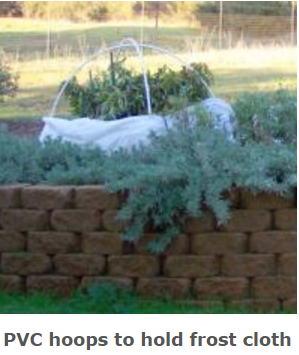
You probably noticed that the covers at Our Garden are white, and are designed to let some light through so they can be left on for several days at a time. You can buy such “frost blankets” at garden centers or online- one brand that I know of is called 'Agribon' They are a lightweight, non-woven material, and come in different weights. You also asked about using this for keeping bees off your mandarins: I would not use the heavier frost blanket for this, but you could use the lighter weight 'row cover' which is often used to keep various moths and bugs off vegetables. Most nurseries and/or hardware stores should stock this or similar types of frost cloth.
Here is a link to an online source which sells these “cloths”, and it has some good information on its use. This is a commercial link, and we do not endorse any particular business, but I include it as it may be helpful to you. https://www.groworganic.com/frost-and-sun-protection/frost-protection/frost-blankets.html. There are many other online suppliers that can be found by Googling “frost protection cloth”.
For now, the covers that you have been using most likely are doing a good job, but being dark in color need to be removed during the day to let light to the plant. If you can provide a frame around the plant to keep the cloth from touching the leaves, that will work best. Here is a UC link with helpful information: http://homeorchard.ucdavis.edu/8100.pdf
You also asked how long the covers can be left on. I can't give you an exact number of days, but the plant should be fine for a few days at a time. I personally use these covers, and I generally leave them attached to the framework, and try to pull them back on warm days to get some airflow and/or sunlight to the plant. I make hoop structures out of re-bar and PVC pipe, and find that kitchen clips (such as you would use for chip bags) are a quick and easy way to attach the cloth to the frame. You can see pictures of such a structure here: http://ucanr.edu/blogs/blogcore/postdetail.cfm?postnum=22776 You can anchor the PVC hoops with 2 foot lengths of re-bar pounded into the ground (make sure the diameter of the re-bar is less than the internal diameter of the pipe!)
I hope this is helpful, and if you have further questions please don't hesitate to get back to us.
Happy Holidays to you, and good luck with your citrus.
Help Desk of the UC Master Gardener Program of Contra Costa County (SMW)
Note: The UC Master Gardeners Program of Contra Costa's Help Desk is available year-round (except the last two weeks of December) to answer your gardening questions. Except for a few holidays, we're open every week, Monday through Thursday for walk-ins from 9:00 am to Noon at 75 Santa Barbara Road, 2d Floor, Pleasant Hill, CA 94523. We can also be reached via telephone: (925)646-6586, email: ccmg@ucanr.edu, or on the web at http://ccmg.ucanr.edu/Ask_Us/ MGCC Blogs can be found at http://ccmg.ucanr.edu/HortCoCo/ You can also subscribe to the Blog (http://ucanr.edu/blogs/CCMGBlog/)
Advice from the Help Desk of the
UC Master Gardener Program of Contra Costa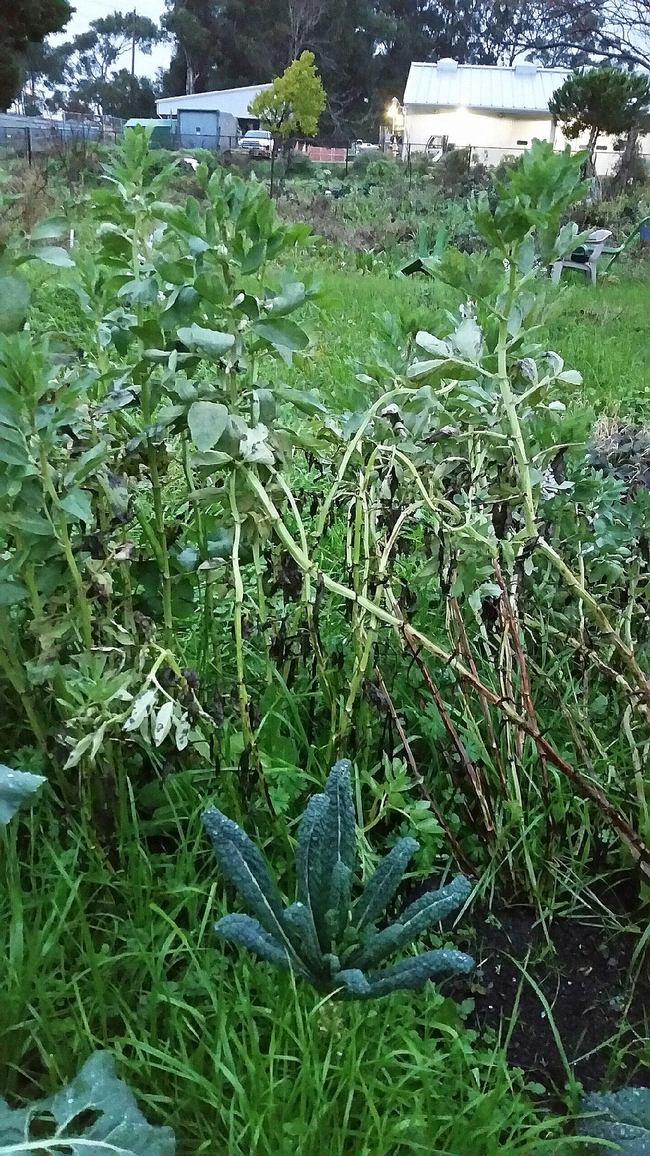
MGCC's Help Desk Response: Thank you for contacting Master Gardeners about your fava beans. And, thank you very much for sending the photo. It was very helpful.
I do not think that the fava beans was damaged by the frost. Frost damage generally appears on the tops of plants rather than the bottoms. Also, fava beans are generally hardy down to 21 degrees. Unless you are in a severe microclimate area, we have yet to see temperatures that low this winter.
Instead, I believe that the beans may have been affected by a fungal disease called Chocolate Spot (Botrytisfabae). Chocolate Spot has been found in fava beans in the northern San Joaquin Valley which is not far from us. Chocolate Spot begins with small red-brown lesions on leaves and stems which can expand and, in an aggressive form, can lead to necrosis (death) of leaves and stem tissue. The aggressive form occurs in high humidity situations, so, if this is the disease you are seeing, it could have come from the earlier rains. I noticed also from the picture that there is a lot of plant material (weeds?) around the fava bean patch which could have also raised or maintained a higher humidity level. It is also possible that this is from some other fungus, but in any case I would suggest hand weeding in the area to increase air circulation to the plants.
With the weeding, it may be possible to save the plants for this year. You have some flowers that would provide you with some beans to enjoy. However, if you are interested in a larger crop you may want to remove these plants now and replant in February or March. That is the planting time for growing fava beans as an edible (as opposed to cover) crop. In either case, once you are done with the plants, I recommend pulling them up and putting them in the commercial green bin for disposal rather than your compost pile. You should also avoid digging them into the soil, since that could cause the fungus to spread.
One other tip: You had mentioned and the photo shows that the plants had fallen over. I have found that to be a common problem with fava beans myself. I use my tomato cages in fava bean patches in my garden to help keep the plants upright.
For more information on fava beans, please see: http://sfp.ucdavis.edu/pubs/brochures/favabean/
While this link is farm-oriented, it has some good background information.
I hope this is helpful. Please let us know if you have further questions or would like more information.
Good luck with your favas!
Help Desk of the UC Master Gardener Program of Contra Costa County (ECS)
Note: The UC Master Gardeners Program of Contra Costa's Help Desk is available year-round to answer your gardening questions. Except for a few holidays, we're open every week, Monday through Thursday for walk-ins from 9:00 am to Noon at 75 Santa Barbara Road, 2d Floor, Pleasant Hill, CA 94523. We can also be reached via telephone: (925) 646-6586, email: ccmg@ucanr.edu, or on the web at http://ccmg.ucanr.edu/Ask_Us/ MGCC Blogs can be found at http://ccmg.ucanr.edu/HortCoCo/ You can also subscribe to the Blog (http://ucanr.edu/blogs/CCMGBlog/).
Advice from the Help Desk of the
UC Master Gardener Program of Contra Costa County
Help Desk Client: I've just bought a home in the County. It has an extensive garden with many different plants. I moved from Southern California where I didn't have to worry about frosts. I have Oleander, Escallonia, Breath of Heaven (Colonema pulchellum), Myrtle (Myrtus communis),
Response from the MGCC's Help Desk:
Thank you for contacting the UC MGCC's Help Desk with you question on frost protection for your landscape plants.
- Oleander can survive in temperatures down to 15-20 degrees, but even a light frost may damage developing buds and leaves which might affect flowering next season.
- Escallonia will suffer damage at 10-15 degrees, but will recover quickly.
- Breath of Heaven will do OK in light frosts, but will need protection from a hard freeze.Pittosporum can withstand brief forays down to 25 degrees.
- Myrtle is good down to 5-15 degrees.
- Lorapetalum should withstand frost, but needs protection from a hard freeze.
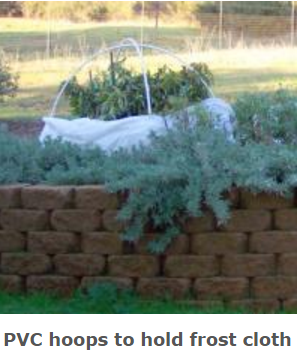
I think all of your plants mentioned above should tolerate frosty weather just fine, but newly planted shrubs will be at more of a risk because their root systems have not yet become established.
Some of the tools to protect your tender plants include frost cloth, sheets, blankets, lights and stakes or framework to hold covers off foliage. Frost cloth has the advantage that, because it allows light and air to penetrate, it can lay directly on foliage and can stay on the plants for a few days at a time. You can find frost cloth at a local nurseries, most home/hardware stores or online. Plastic is not usually recommended to cover your plants; plastic is not a good insulator and can cause more damage, especially if it touches the foliage. However, use of plastic over a frame could work; Ruth Bancroft Gardens in Walnut Creek uses such frames to protect their vulnerable plants.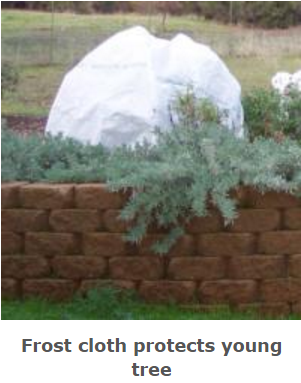
When frosts or freezes are forecast, make sure your plants are well watered (not a worry if we've had rain recently). Cover plants before sunset to capture any heat radiating from the ground. If you use sheets or blankets instead of frost cloth, remove them the next day when the temperature gets above freezing.
Historically, Central County (Walnut Creek) averages a low of 39 degrees, but has gotten down much below that for extended periods in some years. West County usually stays warmer while East County can be similar. However, there are many microclimates throughout the County depending upon elevation, exposure, etc. so you must check out your particular situation. For example, in Walnut Creek in November 1985 it was 25 degrees; December 1990, 19 degrees; and Jan 2007 it dropped to 20 degrees. As you can see, the possibility for real cold exists, but is not likely in any one year.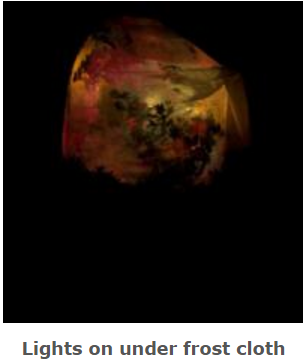
Here is a link to a publication from the UC Sacramento Master Gardeners about frost protection where you will find even more information and photos of how to cover plants: http://sacmg.ucanr.edu/Frost_Protection/ , Pictures are from SacMG document.
Please let us know if you have any more questions. Stay warm!
Note: MGCC's Help Desk closed Dec 19th, 2016 through Jan 2, 2017. However, the UC Master Gardeners Program of Contra Costa's Help Desk is usually available year-round to answer your gardening questions. Except for a few holidays, we're open every week, Monday through Thursday for walk-ins from 9:00 am to Noon at 75 Santa Barbara Road, 2d Floor, Pleasant Hill, CA 94523. We can also be reached via telephone: (925) 646-6586, email: ccmg@ucanr.edu, or on the web at http://ccmg.ucanr.edu/Ask_Us/ MGCC Blogs can be found at http://ccmg.ucanr.edu/HortCoCo/ You can also subscribe to the Blog (http://ucanr.edu/blogs/CCMGBlog/).
Advice from the Help Desk of the
UC Master Gardeners of Contra Costa County
Client's Requests:I'm a new veggie gardener in Contra Costa County (CCC). Would you please help me with some basic veggie growing information for CCC:
- Planting zone for my area
- Last frost date for my area.
- Best veggies to plant for my growing area
- List of germination times for various vegetables such as lettuce and radishes.
MGCC's Help Desk Response:
Thank you for contacting MGCC. We believe the information below should answer your questions about veggie gardening no matter where you live in CCC. We also believe all of the information you seek is readily available on the web either from interactive maps based upon government or authoritative information or downloadable from our own MGCC or other UC web sites.
The responses below are in the order of your request: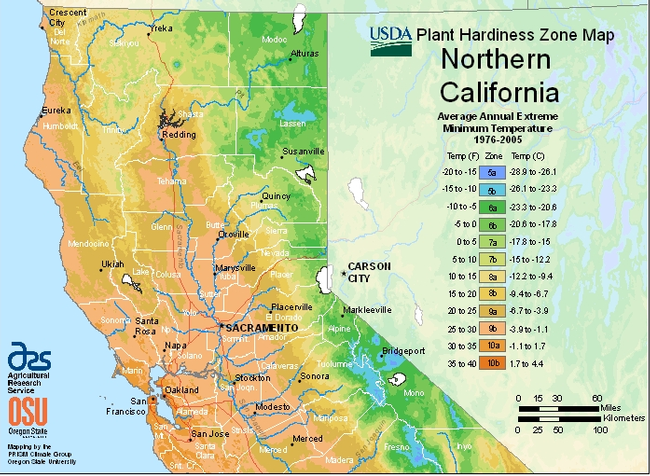
for Northern California
The US Department of Agriculture's Plant Hardiness Zones are used throughout the U.S. Here in CCC the majority of the residential part of CCC is divided into only two zones, either 9 (the majority) or some of the milder SF Bayside areas it would be Zone 10. Both zones can be further split (e.g. 9a and 9b) where the “a” zone is colder. (The colder the winter, the lower the USDA Zone designation). A web-based interactive map based upon the USDA Zones can be found at http://planthardiness.ars.usda.gov/PHZMWeb/InteractiveMap.aspx. This interactive map allows you to put in your zip code and get your USDA Plant Hardiness Zone. There are some other interactive maps on the web as well that based upon USDA data. One that I like to compare data with can be found at http://www.plantmaps.com/interactive-california-usda-plant-zone-hardiness-map.php.
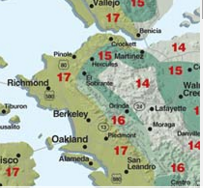
for western CCC
2. Last frost date: The Last Frost Date (LFD) is important as it is an indicator to determine when your tender transplants and/or your seeds can go in the ground without protection from the cold. (Note: Soil temperature is also a consideration and can be measured with a soil thermometer about 3” below ground surface. Soil temperature guidelines can be obtained from the reference in response 4. below). As with Plant Hardiness Zones, the LFD also varies considerably throughout CCC. As a rule-of-thumb, MGCC usually recommends that on average you protect your plants for frost (and even possible freezes) from at least mid-November to mid-March. But, “all weather is local” and frost dates are no exception. Micro-climates, can also be a consideration. Micro-climates are local effects on a small area that can be either natural or man-made, e.g. different temperatures leading to frosts if you are located on a hill or down in a valley, or in the garden if there is no cover. In my garden, the narrow area between the fence and house rarely sees frosts, while the open garden on the back hillside gets frost regularly during the winter. The MGCC last reviewed our LFD in 2010 and the results can be found at http://ccmg.ucanr.edu/files/51309.pdf. The summary results are shown below:
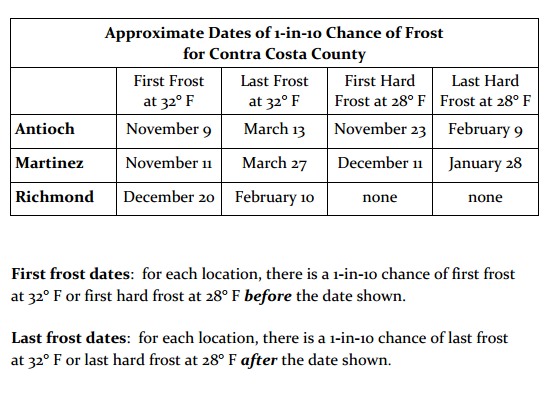
3. Best Veggies: MGCC has reviewed and recommended “best veggies” for planting in CCC several years ago. The results, with links below, are based upon SF Bayside veggie gardening vs. the remainder of the County (Inland):
* Contra Costa County Vegetable Planting Guide for Interior Regions http://ccmg.ucanr.edu/files/131284.pdf
* Contra Costa County Vegetable Planting Guide for Coastal Regions http://ccmg.ucanr.edu/files/131285.pdf
4. Vegetable germination times: Success in propagating veggie seeds is usually determined by noting if/when your seeds sprout and are on their way to becoming seedlings and eventually full-fledged veggies. Necessary soil temperatures and germination times for almost every home garden vegetable imaginable is found on the UCANR web siteUCANR document at http://ucanr.edu/sites/sacmg/files/164220.pdf.
Hopefully, the above answers your questions on getting started in your veggie garden this year. Please do not hesitate in contacting MGCC if you have further questions.
Help Desk of the UC Master Gardeners of Contra Costa County (SIM)
Note: The UC Master Gardeners of Contra Costa's Help Desk is available year-round to answer your gardening questions. Except for a few holidays, we're open every week, Monday through Thursday for walk-ins from 9:00 am to Noon at 75 Santa Barbara Road, 2d Floor, Pleasant Hill, CA 94523. We can also be reached via telephone: (925) 646-6586, email: ccmg@ucanr.edu, or on the web at http://ccmg.ucanr.edu/Ask_Us/ MGCC Blogs can be found at http://ccmg.ucanr.edu/HortCoCo/ You can also subscribe to the Blog (http://ucanr.edu/blogs/blogcore/blogroll.cfm).

